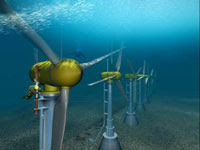![]()
Marine energy can play a key role in reducing CO2 emissions globally, so promoting and developing it is crucial to mitigating the effects of climate change.
- Offshore wind energy is the most developed type of renewable energy source. Northern European countries are leaders in the sector (the United Kingdom and Denmark). Its main advantage is that the resource that can be exploited is greater because offshore wind farms do not have obstacles that reduce wind speed.
- Wave energy is produced by the movement of waves. There are multiple prototypes because wave energy is very irregular. Some are integrated into fixed structures on the coast (dikes, breakwaters and cliffs) or fixed on the seabed. Other types are further from the coast and in shallow waters and are floating structures or located on the seabed and there are also those located in deep waters (up to 100 meters).
Others absorb the energy of the wave regardless of the direction of the waves. With the movement of the waves the device moves up and down, a mechanical movement that is then converted into electrical energy. (Absorbers) and there is also technology through which the wave induces a movement between the sections which activates a hydraulic system coupled to an electric generator.
- Tidal energy (on the other hand) obtains energy from the rise and fall of the sea caused by the tides. A water tank, like a reservoir, is filled during high tide and emptied at low tide, until a suitable difference in level is reached between the sea and the reservoir. From this point, the water is passed through a turbine that generates electricity.
For this technology to be profitable today, a tidal rise of more than 5 metres is required, which only occurs in very specific locations. It also has a significant environmental impact since the optimal locations are usually in estuaries or bays with a great biological diversity.
- Ocean currents are also capable of generating energy. Current technology is very similar to offshore wind, but in this case the devices are submerged. Currents with velocities between 1 and 3 m/s are required for the installation to be cost effective, which once again limits the locations for this type of technology. Currently the greatest potential is in the United Kingdom.
- Ocean Thermal Energy Conversion (OTEC) technologies are able to take advantage of the temperature difference between the sea surface and deep waters, which is known as the ocean thermal gradient. A temperature difference of more than 20ºC is required, which is why equatorial and subtropical regions are the most suitable for this type of energy.
All these projects are still in the preliminary phase. However, there are experimental installations in Hawaii, India and Japan. Among them, the floating platform installed in India in 2001 with a capacity of 1 MW stands out. This platform, called Sagar Shakti (in Sanskrit, “the power of the ocean”) was launched by the National Institute of Ocean Technology of India and the University of Saga (Japan). Located 40 kilometres off the coast of Tamilnadu, it is a floating platform that uses water collected at a depth of 1,000 metres.
Finally, there are the Osmotic Pressure technologies (also called Blue Energy) and Saline Gradient.
The first of these is based on the phenomenon of osmosis, which means they are able to take advantage of the difference in pressure between fresh water and salt water to produce energy.
Norwegian state-owned energy group Statkraft has inaugurated the world's first prototype of this type of technology, located in the Oslo Fjord.
In the case of the salinity gradient, energy is obtained from the difference in salt concentration between seawater and river water. When fresh water mixes with salt water, energy is released that could theoretically be used.
It is important to recognise the high potential of this technology, although it is still underdeveloped and its cost remains very high.
FOUNTAIN: OCEAN

